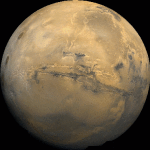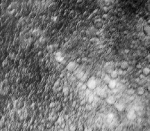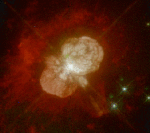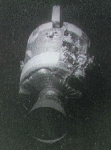
|
Astronomy Picture Of the Day (APOD)
 The Exploration of Mars
The Exploration of Mars
16.07.1995
Thirty years ago NASA's exploration of Mars began. In July of 1965 the Mariner 4 spacecraft flew within 6,000 miles of Mars and returned 21 pictures of the mysterious red planet. NASA...
 The Crater Chain
The Crater Chain
15.07.1995
NASA's robot spaceprobe Voyager 1, took this closeup image of the surface of Jupiter's crater scarred moon Callisto in 1979. A mysterious chain of craters is seen to extend diagonally across the image (upper left to lower right). What could cause the craters to line up in such a regular fashion?
 Comet Impacts on Jupiter
Comet Impacts on Jupiter
14.07.1995
In July of 1994, pieces of Comet Shoemaker-Levy 9, also known as the "string of pearls" comet, collided with the planet Jupiter. As the comet fragments smashed in to Jupiter, the resulting explosions scattered large quantities of dusty cometary debris into the Jovian atmosphere.
 A String Of Pearls
A String Of Pearls
13.07.1995
Comet Shoemaker-Levy 9, named after its co-discoverers, was often referred to as the "string of pearls" comet. It is famous for its unusual appearance as well as its collision with the planet Jupiter!
 Eta Carinae Before Explosion
Eta Carinae Before Explosion
12.07.1995
The star Eta Carinae, at the center of the photo, will likely destroy itself in a spectacular explosion in a few million years - or sooner! Currently it is one of the brightest, most massive, and least stable stars known. Much of the gas in this Hubble Space Telescope photograph was blown off the star itself.
 Microlensing of the Einstein Cross
Microlensing of the Einstein Cross
11.07.1995
The famous "Einstein Cross" is a case where a single object is seen four times. Here a very distant QSO happened to be placed right behind a massive galaxy. The gravitational effect...
 Abell 2218: A Galaxy Cluster Lens
Abell 2218: A Galaxy Cluster Lens
10.07.1995
Sometimes one of the largest concentrations of mass known can act like a lens. Almost all of the bright objects in this image are galaxies in the cluster known as Abell 2218. The cluster...
 A Meteoric View of Apollo 13
A Meteoric View of Apollo 13
9.07.1995
Meteors, also called shooting stars, normally begin as bits of dust from the tails of comets or even small pieces chipped off asteroids. Falling toward Earth, these particles enter the atmosphere at extremely high speeds. Friction with the air heats them up and makes them glow brightly.
 Damage to Apollo 13
Damage to Apollo 13
8.07.1995
In April of 1970, after an oxygen tank exploded and damaged their service module, the Apollo 13 astronauts were forced to abandon their plans to make the third manned lunar landing. The extent...
 Lunar Farside from Apollo 13
Lunar Farside from Apollo 13
7.07.1995
In April of 1970, after an explosion damaged their spacecraft, the Apollo 13 astronauts were forced to abandon their plans to make the third manned lunar landing. Still, while coasting around the moon in their desperate attempt to return to earth they were able to photograph the moon's far side.
|
January February March April May June July August September October November December |
|||||||||||||||||||||||||||||||||||||||||||||||||